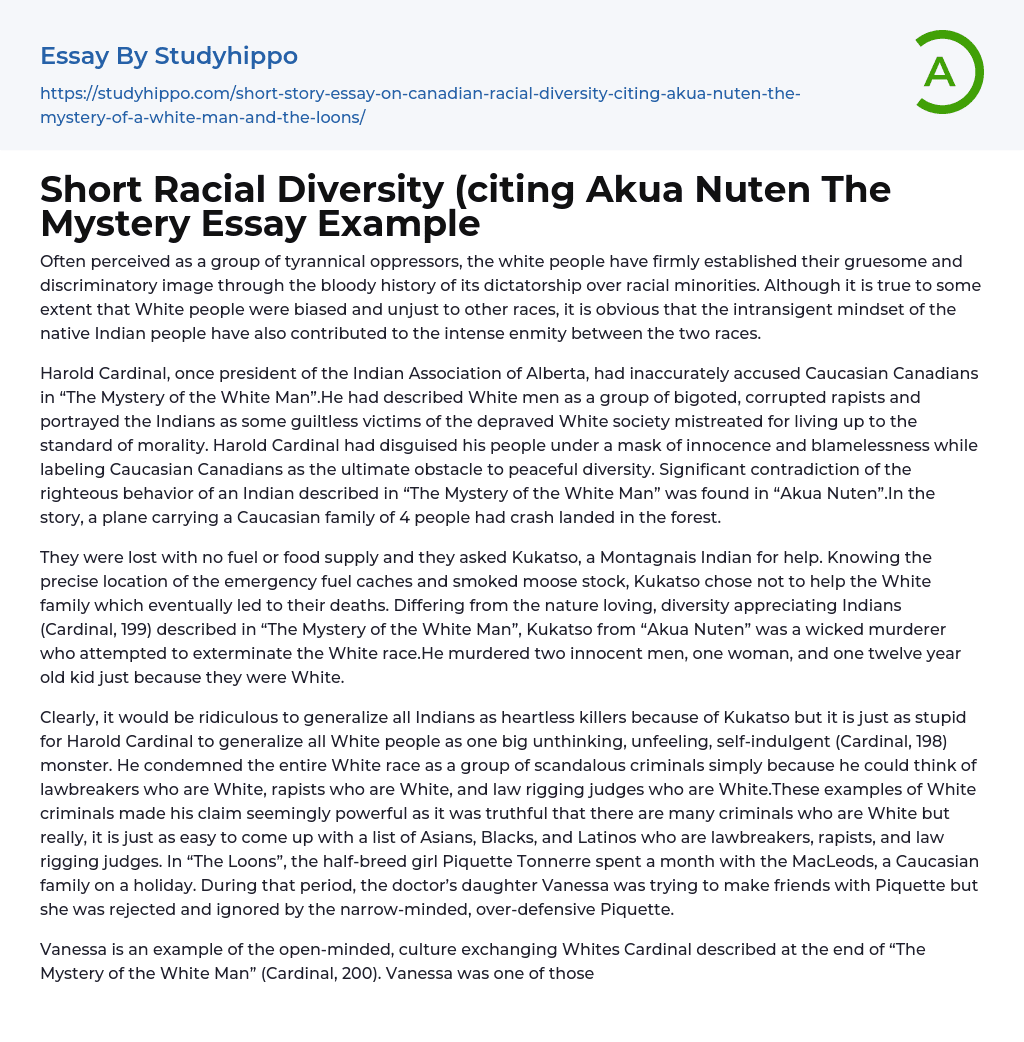

Short Racial Diversity (citing Akua Nuten The Mystery Essay Example
Often perceived as a group of tyrannical oppressors, the white people have firmly established their gruesome and discriminatory image through the bloody history of its dictatorship over racial minorities. Although it is true to some extent that White people were biased and unjust to other races, it is obvious that the intransigent mindset of the native Indian people have also contributed to the intense enmity between the two races.
Harold Cardinal, once president of the Indian Association of Alberta, had inaccurately accused Caucasian Canadians in “The Mystery of the White Man”.He had described White men as a group of bigoted, corrupted rapists and portrayed the Indians as some guiltless victims of the depraved White society mistreated for living up to the standard of morality. Harold Cardinal had disguised his people under a mask of innocence and blamel
...essness while labeling Caucasian Canadians as the ultimate obstacle to peaceful diversity. Significant contradiction of the righteous behavior of an Indian described in “The Mystery of the White Man” was found in “Akua Nuten”.In the story, a plane carrying a Caucasian family of 4 people had crash landed in the forest.
They were lost with no fuel or food supply and they asked Kukatso, a Montagnais Indian for help. Knowing the precise location of the emergency fuel caches and smoked moose stock, Kukatso chose not to help the White family which eventually led to their deaths. Differing from the nature loving, diversity appreciating Indians (Cardinal, 199) described in “The Mystery of the White Man”, Kukatso from “Akua Nuten” was a wicked murderer who attempted to exterminate the White race.He murdered two innocent men, one woman, and one twelve yea
old kid just because they were White.
Clearly, it would be ridiculous to generalize all Indians as heartless killers because of Kukatso but it is just as stupid for Harold Cardinal to generalize all White people as one big unthinking, unfeeling, self-indulgent (Cardinal, 198) monster. He condemned the entire White race as a group of scandalous criminals simply because he could think of lawbreakers who are White, rapists who are White, and law rigging judges who are White.These examples of White criminals made his claim seemingly powerful as it was truthful that there are many criminals who are White but really, it is just as easy to come up with a list of Asians, Blacks, and Latinos who are lawbreakers, rapists, and law rigging judges. In “The Loons”, the half-breed girl Piquette Tonnerre spent a month with the MacLeods, a Caucasian family on a holiday. During that period, the doctor’s daughter Vanessa was trying to make friends with Piquette but she was rejected and ignored by the narrow-minded, over-defensive Piquette.
Vanessa is an example of the open-minded, culture exchanging Whites Cardinal described at the end of “The Mystery of the White Man” (Cardinal, 200). Vanessa was one of those who have offered their culture and heritage; she was striving to discover the foreign ethnicity of the Indians but the cynical, self-protective Piquette had refused to befriend her. Both of the stories “Akua Nuten” and “The Loons” have reflected the fact that White people do try to reach out and discover the Indian culture.Nevertheless, they were either neglected by the unsociable Piquette or frightened at gunpoint by the racist Kukatso (Theriault, 128). Varying from the friendly and
submissive attitude Cardinal described all Indians to have, Piquette was antagonistic and ignorant to learn or accept the White culture. Much like one of those immoral Caucasians described in “The Mystery of the White Man”, Kukatso was a despicable killer who attempted to annihilate the entire Caucasian race demonstrating racism and hatred at the zenith.
The Mystery of the White Man” is a controversial piece. Harold Cardinal has offered his subjective perspective of racism as an Aboriginal Canadian. He was racist himself to broadly generalize all White men as corrupted criminals and rapists. He had recklessly accused Caucasian Canadians, holding them accountable for all problems generated by racism while camouflaging the Indians as a virtuous group who are oppressed and mistreated in the Caucasian dominated Canadian society.Harold Cardinal had disguised his people under a mask of innocence and blamelessness while labeling Caucasian Canadians as the ultimate obstacle to peaceful diversity. Work Cited Cardinal, Harold.
“The Mystery of the White Man. ” Who Speaks For Canada? Ed. Desmond Morton and Morton Weinfeld. Toronto: McCelland & Stewart Inc, 1998. 237-239. Laurence, Margaret.
“The Loons. ” Heartland. Ed. Katheryn Maclean Broughton.
Scarborough: Nelson Canada, 1983. 10-24. Theriault, Yves. “Akua Nuten. ” Heartland. Ed.
Katheryn Maclean Broughton. Scarborough: Nelson Canada, 1983. 121-130
- Malcolm X essays
- Black Lives Matter essays
- Antisemitism essays
- Ku Klux Klan essays
- Miscegenation essays
- Racial Segregation essays
- I Have a Dream essays
- Martin Luther King essays
- Racial Inequality essays
- Black History Month essays
- Black People essays
- Ageism essays
- Cultural Diversity essays
- Discrimination essays
- Diversity essays
- Gender Discrimination essays
- Multiculturalism essays
- Oppression essays
- Peer Pressure essays
- Racial Profiling essays
- Sexism essays
- Adaptation essays
- Adventure essays
- Adversity essays
- Aging essays
- Alcohol essays
- Barbie Doll essays
- Beauty essays
- Care essays
- Carpe diem essays
- Change essays
- Chess essays
- Chicken essays
- Choices essays
- Contrast essays
- Crops essays
- Development essays
- Dream essays
- Evil essays
- Experience essays
- Family essays
- Farm essays
- Fire essays
- First Love essays
- Focus essays
- Greed essays
- Hero essays
- Holiday essays
- House essays
- Housing essays



